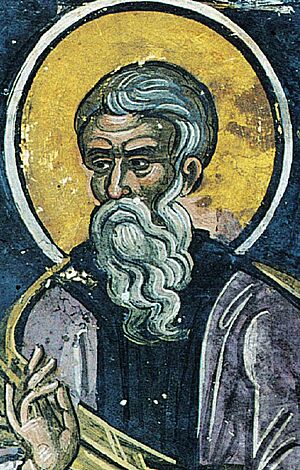Theodore of Sykeon facts for kids
Quick facts for kids SaintTheodore of Sykeon |
|
|---|---|
 |
|
| Bishop of Anastasioupolis | |
| Born | first half of the 6th century Sykeon (near modern Kayabükü, Beypazarı) |
| Died | 613 Orsan Priory, Cher |
| Venerated in | Greek Orthodox Church |
| Major shrine | Monastery of St. George of Mangana, Constantinople (destroyed) |
| Feast | 22 April |
Saint Theodore of Sykeon, also called Theodore the Sykeote, was a respected religious person from the Byzantine Empire. He lived in the early 600s. The story of his life, written after 641, is a very important old record about the time of Emperor Heraclius (who ruled from 610 to 641). People celebrate his feast day on April 22.
Contents
The Life of Saint Theodore
Theodore's Early Years
Theodore was born in a village called Sykeon in a region named Galatia. A main road for the emperor's mail and travelers passed through this village. On this road was an inn run by a woman named Mary, her mother Elpidia, and her sister Despoinia. Theodore was Mary's son. His father, Cosmas, was famous for doing acrobatic tricks with camels in the hippodrome (a large stadium) in Constantinople. He even worked for the emperor. The story of Saint Theodore shows that the women in his family were strong and could earn a living from their inn.
When Theodore was about twelve years old, a serious sickness, like the bubonic plague, spread through the village. Theodore got very sick and almost died. His family took him to a special place dedicated to Saint John the Baptist near the village. They laid him at the entrance, and he got better, returning home.
Theodore often visited a shrine dedicated to St. George, a Christian hero. This shrine was on a rocky hill near his village. When he was fourteen, he decided to live there. Even at this young age, Theodore was known for being able to help people heal.
Living in Solitude
Later, Theodore decided to live completely alone in a cave not far from the Saint George shrine. He asked a church helper to bring him bread and water. He kept his hiding place a secret from everyone else.
Saint Theodore lived alone for two years. News of his special way of life reached the local bishop, Theodosius. The bishop made Theodore a deacon, and later, a priest, even though Theodore was only eighteen years old.
After this, Theodore decided to travel to Jerusalem and other holy places. He also visited monasteries and hermits (people who live alone for religious reasons) in the desert. At a monastery called Choziba, he received the special clothes of a monk. However, he soon returned to Galatia.
Becoming a Bishop
Theodore was chosen to be the Bishop of Anastasioupolis. On his third trip to the Holy Land, Theodore wanted to stop being a bishop. He stayed for some time at a famous monastery called the Laura of Saba. This place attracted many people who wanted to live a perfect religious life. But Saint George appeared to him in a dream, telling him to go back. So, Theodore returned to his role as bishop in Anastasioupolis.
During the rule of Emperor Maurice (582–602), Theodore predicted the emperor's death. He also warned of "great troubles" and "terrible problems" that would affect the world. His predictions came true when the Persian war started, lasting 26 years, after Maurice's death.
Theodore was a good friend of Emperor Phocas's family. However, he told Phocas that he would only pray for him if Phocas stopped harming many people. After Emperor Heraclius successfully took power, Theodore helped save the life of Domentziolus, who was Phocas's nephew. In return, Heraclius asked Saint Theodore to "pray for [Heraclius] and his rule."
Saint Theodore of Sykeon had good relationships with Patriarch Sergius of Constantinople, a very important church leader. However, historian Walter Kaegi suggests that Emperor Heraclius might have always felt a little unsure about Saint Theodore. In the spring of 613, Heraclius asked for Saint Theodore's blessing before fighting the Sassanids (Persians). Saint Theodore blessed him and invited him to dinner. Heraclius said no because he was in a hurry. But the saint said that not accepting his gifts was a "sign of our defeat." Sadly, Heraclius did lose the Battle of Antioch soon after.
Saint Theodore of Sykeon died on April 22, 613.
Honoring Saint Theodore
After his death, Saint Theodore's body was quickly taken to Constantinople. This was done to protect his remains from the ongoing Persian war. It was also believed that his presence would bring divine protection to the city. A grand ceremony was held to welcome his remains, connecting Saint Theodore with Emperor Heraclius's government.

